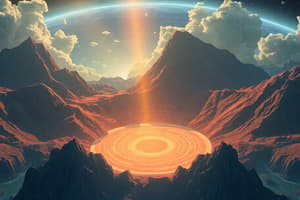Podcast
Questions and Answers
What is the primary method used to determine the location of an earthquake epicenter?
What is the primary method used to determine the location of an earthquake epicenter?
- Data from two seismic stations
- Satellite imagery
- Data from at least three seismic stations (correct)
- Visual observation from the surface
What type of plate boundary is characterized by plates moving towards each other?
What type of plate boundary is characterized by plates moving towards each other?
- Static Boundary
- Convergent Boundary (correct)
- Transform Boundary
- Divergent Boundary
Which of the following is NOT considered a major tectonic plate?
Which of the following is NOT considered a major tectonic plate?
- Himalayan Plate (correct)
- Pacific Plate
- Indo-Australian Plate
- African Plate
Which phenomenon is most likely to occur at transform plate boundaries?
Which phenomenon is most likely to occur at transform plate boundaries?
Hotspots are defined as areas in the mantle that create what geological feature?
Hotspots are defined as areas in the mantle that create what geological feature?
What layer of the Earth is primarily composed of liquid and consists mainly of iron and nickel?
What layer of the Earth is primarily composed of liquid and consists mainly of iron and nickel?
How do convection currents contribute to tectonic plate movement?
How do convection currents contribute to tectonic plate movement?
Who proposed the Continental Drift Theory, suggesting that continents were once part of a supercontinent?
Who proposed the Continental Drift Theory, suggesting that continents were once part of a supercontinent?
Flashcards are hidden until you start studying
Study Notes
Earthquake Epicenter
- Definition: The point on the Earth's surface directly above the focus of an earthquake.
- Determination: Calculated using data from at least three seismic stations.
- Significance: Helps in assessing the impact area and response efforts.
Major Tectonic Plates
- List of Major Plates:
- Pacific Plate
- North American Plate
- Eurasian Plate
- African Plate
- South American Plate
- Indo-Australian Plate
- Antarctic Plate
- Movement: Plates move due to convection currents in the mantle.
Plate Boundaries
- Types:
- Convergent Boundaries: Plates move towards each other, causing subduction or mountain formation.
- Divergent Boundaries: Plates move apart, leading to seafloor spreading.
- Transform Boundaries: Plates slide past each other, causing earthquakes.
Effects of Plate Boundaries
- Earthquakes: Common at transform boundaries due to friction.
- Volcanoes: Formed at convergent and divergent boundaries.
- Mountain Ranges: Created by the collision of tectonic plates at convergent boundaries.
Hotspots
- Definition: Areas in the mantle where plumes of hot magma rise, creating volcanoes.
- Example: The Hawaiian Islands formed over a hotspot.
- Characteristics: Can exist away from plate boundaries.
Earth's Interior
- Layers:
- Crust: Thin outer layer where we live.
- Mantle: Thick layer of semi-solid rock; convection currents occur here.
- Outer Core: Liquid layer composed mainly of iron and nickel.
- Inner Core: Solid center of the Earth, extremely hot.
Convection Currents
- Definition: Movement of fluid caused by differences in temperature and density.
- Role in Tectonics: Drives the movement of tectonic plates.
- Process: Hot material rises, cools and sinks, creating a cycle.
Seafloor Spreading
- Definition: The process where new oceanic crust forms at mid-ocean ridges and pushes older crust away.
- Evidence: Magnetic striping and age of rocks indicate the history of seafloor formation.
- Impact: Contributes to continental drift and the expansion of ocean basins.
Continental Drift Theory
- Proposed by: Alfred Wegener in the early 20th century.
- Concept: Continents were once part of a supercontinent (Pangaea) that drifted apart.
- Evidence: Fossil similarities, geological formations, and climate evidence support the theory.
Earthquake Epicenter
- Point on Earth’s surface directly above the earthquake's focus.
- Determined using data from a minimum of three seismic stations.
- Essential for assessing potential impact areas and organizing disaster response.
Major Tectonic Plates
- Key plates include the Pacific, North American, Eurasian, African, South American, Indo-Australian, and Antarctic Plates.
- Movement occurs due to convection currents in the Earth's mantle.
Plate Boundaries
- Convergent Boundaries: Plates collide, leading to subduction zones or mountain formation.
- Divergent Boundaries: Plates separate, resulting in seafloor spreading.
- Transform Boundaries: Plates slide against one another, commonly causing earthquakes.
Effects of Plate Boundaries
- Earthquakes frequently occur at transform boundaries due to friction.
- Volcanoes are primarily formed at convergent and divergent boundaries.
- Mountain ranges are generated from the collision of tectonic plates at convergent boundaries.
Hotspots
- Areas in the mantle where hot magma plumes rise, resulting in volcanic activity.
- The Hawaiian Islands are a notable example formed over a hotspot.
- Hotspots can exist independent of tectonic plate boundaries.
Earth's Interior
- The Earth consists of four main layers:
- Crust: The thin outer layer, where human life exists.
- Mantle: A thick layer of semi-solid rock that contains convection currents.
- Outer Core: A liquid layer composed of iron and nickel.
- Inner Core: The solid, extremely hot center of the Earth.
Convection Currents
- Defined as the fluid movement driven by temperature and density differences.
- Crucial for the driving forces behind tectonic plate movement.
- Cycle involves hot material rising, cooling, and then sinking.
Seafloor Spreading
- Process where new oceanic crust is created at mid-ocean ridges, pushing older crust outward.
- Evidence includes magnetic striping and the varying ages of ocean floor rocks.
- Plays a vital role in supporting the theory of continental drift and the expansion of ocean basins.
Continental Drift Theory
- Introduced by Alfred Wegener in the early 20th century.
- Proposes that continents were once joined as a single supercontinent, Pangaea, which slowly separated.
- Supported by evidence such as fossil correlations, geological formations, and similarities in ancient climates.
Studying That Suits You
Use AI to generate personalized quizzes and flashcards to suit your learning preferences.



